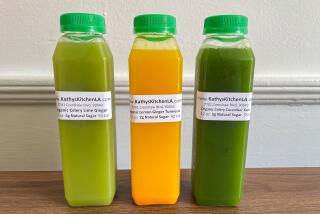Americans Showing an Increasing Interest in O.J.--Orange Juice, That Is : Consumers: Analysts say it’s health and fitness, not a link to a certain ex-defendant, that sent sales up 1.5% over last year.
- Share via
Maybe it’s a subliminal reaction to the O.J. Simpson trial and its domination of the headlines that’s sending sales of the other famous O.J. higher.
Americans will quaff 1.5% more orange juice this year than they did last year for a total of 1.35 billion gallons, said Bobby F. McKown, chief executive of the Lakeland, Florida, trade group Florida Citrus Mutual.
McKown and his group steadfastly rebut any notion that rising orange-juice consumption is somehow related to the sensational trial of the ex-football star nicknamed “Juice.” If not the trial, what’s fueling the growth?
“Health and wellness,” said Michael Sparks, deputy director of the Florida Department of Citrus.
A $25-million television ad campaign by Cordiant Plc’s Saatchi & Saatchi touts orange juice as a fat-free, cholesterol-free and sodium-free food that can help lower heart disease, ward off cancer and energize the body.
One zany spot shows a man swatting a fly with his newspaper. The pesky bug, which had just lapped up some orange juice, blasts back to bore a big hole in the newspaper rather than head into the hereafter.
The spots represent a change from the way orange juice traditionally has been flogged--centering a campaign around a prominent orange-juice drinker. Ads featuring Anita Bryant and most recently Rush Limbaugh brought unwanted controversy.
After the Florida Citrus Commission plowed more than $1 million into ads on Limbaugh’s talk show in May, 1994, several groups, including the National Organization for Women and the Gay and Lesbian Americans boycotted orange juice. Limbaugh fans staged “buycotts,” and snapped up the juice to counter-protest.
Generic ads aren’t all that’s fueling the category. A high-voltage juice war between Coca Cola Co.’s Minute Maid and Seagram & Co.’s Tropicana erupted last spring when Minute Maid unveiled a $100-million marketing program, including a radical redesign of the packaging. The year before, the company spent just $15 million on advertising.
Minute Maid jettisoned the 30-year-old black packaging for a color that has more in common with fruit.
“The old one was familiar but didn’t activate the equities of our 49-year-old brand and didn’t show what we got,” said Don Knauss, senior vice president for marketing at Houston-based Coca Cola Foods Co.
Customers’ intent to purchase has risen to 66% from 40% since then, although supermarket sales have dipped more than 5%. Knauss said he expects Minute Maid to steal market share from Tropicana and to grow the juice category, which has been flat for the past decade.
For its part, Tropicana has not advertised for the past six months, as it moves its campaign from the Leo Burnett ad agency to True North’s FCB/Leber Katz.
Mark Gutsche, vice president of Tropicana Products Inc. in Bradenton, Fla., said several new Tropicana products were recently introduced and a tie-in is planned for the video release of the movie “Apollo 13.”
Tropicana has about a third of the juice market and Minute Maid has about a quarter. Regional and store brands account for the rest.
Orange juice has been battered by its relatively high cost compared with soda and the massive marketing budgets of soft drinks, said Tom Pirko, president of Bevmark, a New York based consultancy.
And while juice advertising is becoming more ethereal and image-oriented, the business is engaged in “bloodletting” price competition, Pirko said, because orange juice is often seen as a commodity item with little difference among brands. “The discounting has fired demand,” he said, “but made it real tough to make money.”
Each American consumes an average 5.6 gallons of orange juice per a year with about 92% of the population drinking it--largely for breakfast. Ready-to-serve-juice accounts for roughly two-thirds of sales while frozen, which accounts for much of the rest, has been declining in recent years. Fresh-squeezed makes up less then 1% of the $3-billion market.
Orange juice is cheaper in the Northeast than anywhere else in the country. Sales tend to remain fairly consistent throughout the year, with a tiny blip during winter months.
Though sales are up this year--after a 2.9% decline in 1994--growers aren’t content.
“We’re looking at larger crops and lower consumer prices, “ McKown said. “That means we’ll have to grow faster and look overseas.”
More to Read
Inside the business of entertainment
The Wide Shot brings you news, analysis and insights on everything from streaming wars to production — and what it all means for the future.
You may occasionally receive promotional content from the Los Angeles Times.









